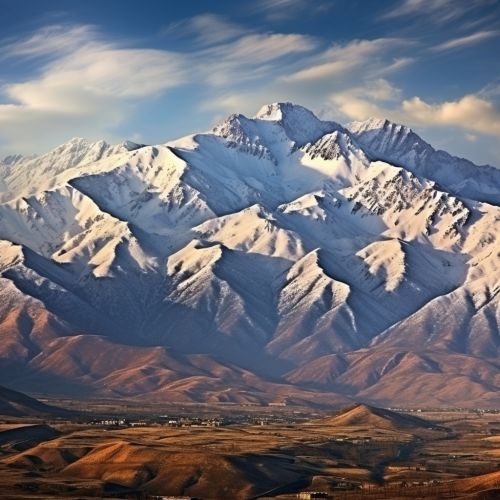Zagros Mountains
Geography
The Zagros Mountains are a major mountain range in Iran, Iraq, and southeastern Turkey. This range is part of the larger alpine-Himalayan mountain system, which stretches from the Atlantic Ocean to the Himalayas. The Zagros Mountains cover an area of approximately 1,000,000 square kilometers, making them the largest mountain range in Iran and Iraq. They extend from the southeast of Turkey near Lake Van to the Hormuz Strait, forming a natural barrier between Iran and Iraq.


Geology
The Zagros Mountains are primarily made up of limestone and dolomite, with some granite and basalt. The mountains are a result of the collision between the Arabian and Eurasian tectonic plates, which began in the Late Cretaceous period and continues today. This collision has resulted in a series of parallel ridges and valleys, known as "Zagros Folded Zone", and a volcanic arc, known as "Zagros Main Volcanic Arc". The mountains are also home to several salt domes, which are a type of structural dome formed when a thick bed of evaporite minerals found at depth intrudes vertically into surrounding rock strata.
Climate
The Zagros Mountains have a semi-arid climate, with hot summers and cold winters. The range receives most of its precipitation in the form of snow during the winter months. The western and northern parts of the range receive more rainfall than the eastern and southern parts, due to the Mediterranean climate influence. This precipitation supports a variety of plant and animal life in the mountains, making the Zagros one of the most important ecological regions in the Middle East.
Flora and Fauna
The Zagros Mountains are home to a rich variety of plant and animal species. The lower slopes of the mountains are covered in oak, pistachio, and almond trees, while the higher elevations are home to juniper and cypress trees. The mountains are also home to a number of endemic plant species, including the Zagros poppy and the Zagros holly.
The mountains are also home to a variety of wildlife, including the Persian leopard, the wild goat, the mouflon, and the Persian fallow deer. The Zagros Mountains are also an important bird area, with a number of endemic and migratory bird species found in the region.
Human Settlement
The Zagros Mountains have been inhabited by humans for thousands of years. The mountains are home to a number of ethnic groups, including the Kurds, Lurs, and Bakhtiari. These groups have traditionally lived a semi-nomadic lifestyle, herding sheep and goats in the high pastures of the mountains.
The Zagros Mountains are also home to a number of important archaeological sites, including the ancient city of Susa and the Behistun Inscription. These sites provide evidence of the rich history of human settlement in the region.
Economic Importance
The Zagros Mountains are an important economic resource for the countries in which they are located. The mountains are rich in natural resources, including oil, gas, and minerals. The Zagros basin is one of the oldest known oil-producing regions in the world, and it continues to be a major source of petroleum for Iran and Iraq.
The mountains also provide a number of ecosystem services, including water provision, soil retention, and carbon sequestration. The forests of the Zagros are an important source of timber and non-timber forest products, such as nuts and medicinal plants.
Conservation Issues
Despite their ecological and economic importance, the Zagros Mountains face a number of conservation challenges. These include deforestation, overgrazing, and illegal hunting. Climate change also poses a significant threat to the mountains, with rising temperatures and changing precipitation patterns likely to impact the region's biodiversity.
Efforts are being made to address these challenges and conserve the Zagros Mountains. These include the establishment of protected areas, the promotion of sustainable land use practices, and the implementation of conservation projects aimed at protecting the region's biodiversity.
